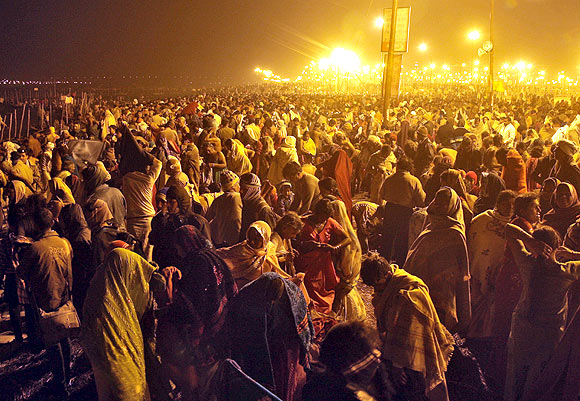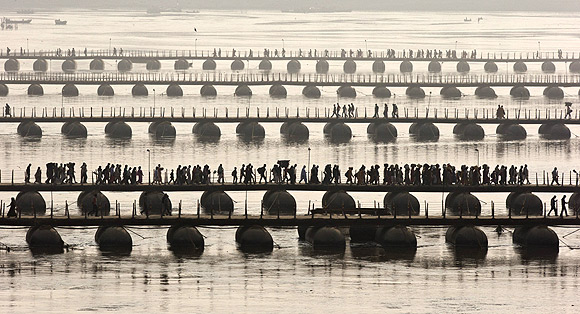
The rich and the pauper, the austere and the ostentatious, the atheist and the seer, the iconoclast and the idol worshipper, all find warmth and solace in the icy waters of the Sangam, notes Tarun Vijay.
The Kumbh Mela, the biggest religious event on the planet, has been hurt immensely by the secular character of the rulers, whether at the Centre or in the state.
The statement by the Uttar Pradesh chief minister that he may visit Allahabad if there was a need rubs salt into Hindu wounds.
Sensitive about his 'pro-Muslim' image, he was not only lethargic and methodically insensitive to the emergent needs of millions of pilgrims converging on Allahabad for the Kumbh Mela, but showed a visibly lackadaisical attitude.
If there is a tragedy in the family, would the son say if there is a need I will come to express grief? Chief Minister Akhilesh Singh Yadav is answerable to his people for how many times he reviewed the security and management of the Kumbh Mela.
Putting a Muslim minister in charge of the Kumbh Mela is not a matter of complaint. We trust all Indians alike. But secular Hindus are more insensitive to the legitimate demands of Hindus because of communal considerations and the false thinking that if they are seen to be helping Hindus, their Muslim vote bank will be annoyed.
In fact, Muslims think that if a Hindu can ditch his own community, how can he be loyal to them!
The central government's railway ministry also shares the sin of being a part of the same neglect. The feeling among pilgrims is that the Kumbh Mela being a Hindu event, nothing much would be done for the common villager who comes to the Kumbh Mela facing all odds, difficulties, travels without reservation on trains and without having luxury tents on the banks of the Sangam.
He gets the boot and meets death thanks to the sheer apathy of an administration that remains indifferent to Hindu sensitivities.
While paying homage to the common Indians who died because the State did not make as much cautionary arrangements as it should have, we must reserve our angst to make changes in this anti-Hindu polity and present a human face equally good to everybody, without any communal prejudices.
This Kumbh Mela, occurring at a very significant juncture in India's polity and social life, may well shake up sleepy Hindus from their slumber and petty infighting.
The site of the Kumbh turns into a nation of righteousness and piety every time millions of devotees converge there.
The rich and the pauper, the austere and the ostentatious, the atheist and the seer, the iconoclast and the idol worshipper, all find warmth and solace in the icy waters of the Sangam, the confluence of the Ganga, the Yamuna and the invisible Saraswati.
The Sanskrit word 'Prayag', the original name of this holy city, means confluence. Muslim invaders renamed it as Allahabad. The demand to revert to its original name has fallen on deaf ears so far.
Please ...

The Kumbh Mela is virtually the Republic of Dharma.
It influences the lives of millions of the faithful converging from almost all parts of the world.
In the chilly winter of Magh, the Kumbh witnesses the most unique submissions of pious and devoted Hindus and all branches of Dharmic traditions and paths born in India -- Sikhs, Buddhists, Jains, Saivites, Shakts, Lingayats, and innumerable others.
The devotees have kept the tradition alive for a millennium, facing all the barbarians, invaders, atheists and other enemies of their Dharma with a resilience and courage that is incomparably unique.
Centuries before, the Kumbh Mela was an occasion where the king and the commoner mingled with each other and the ever-shining example of emperors like Harsh who would donate all that he had and leave for home barefoot clad in a single piece of cloth. It still finds a place of grace in the hearts of devotees.
Religious belief apart, the Kumbh Mela provides a great opportunity for non-State stakeholders in the nation's destiny to meet and deliberate on the state of the nation, find ways to solve contemporary issues of conflict, and chart a new path commensurate with the changing times, even while keeping eternal values intact.
That is what makes the Sanatan Dharma, the eternal path of righteousness, a way of life relevant for all time. Hindus have survived the vicissitudes of history and the most savage invasions and attacks thanks to the strength of Sanatan Dharma.
They walked with the times and yet kept the original flame burning while others either became extinct, timed out, or irreparably dogmatic, irrelevant and fossilised.
Can this event remain distant and delineated from the contemporary crisis India confronts? While it may be unthinkable for us to visualise a conference of the Congress, the Bharatiya Janata Party etc discussing the problems the nation is facing, deliberating collectively as Indians and rising above their petty political profit and loss accounts to find a way for national progress and prosperity, it is a very natural event for the sadhus, seers, scholars and activists belonging to different ways of worship, rituals, prayers, and paths of sadhana or spiritual penance.
They come together, discuss everything threadbare and express their opinions openly, making sincere efforts to find a consensual solution and a future programme benefitting the masses.
One of the most inspiring events was this as reported in the media: 'Making history of sorts, the ongoing Maha Kumbh on Thursday saw 100 former scavenging women, considered 'untouchable' for centuries, take a holy dip at the Sangam and share food with top Hindu seers. It was a kind of salvation for the former 'night-soil' carriers from Rajasthan's Alwar and Tonk districts as they dined inside the famous Baghabanbari Akhara of Swami Narendra Giri with hundreds of high caste Hindu religious leaders and mahants after a dip at the Sangam ghat.'
Though hundreds of Sikh sects camp there, the Shiromani Gurdwara Prabandhak Committee's main camp is a centre of great attraction. Buddhists and Jain seers too have their camps.
It is a pity that the Uttar Pradesh government has not come up with matching enthusiasm for the Kumbh Mela. A look at its official Web site shows how sincere they are about it. But nobody complains because nobody depends on the state government for guidance or facility.
The instruments of secular government, whether at the Centre or in the state, have remained almost untouched and aloof from this mega event.
The exorbitant airline fare hikes, the paucity of adequate trains, the absence of worldwide publicity campaign notwithstanding, the show of people's power dwarfs the so-called might of State players.
Please ...

The entire Kumbh Mela area, designated as a district, spans over 58.3 square kilometres.
More than a hundred million people visit this area, which is estimated to be 200 times bigger than the Vatican.
During this Kumbh Mela a Dharma Sansad or parliament of religion was convened to deliberate on the various issues faced by society.
Rashtriya Swayamsevak Sangh Sarsanghchaalak Mohan Bhagwat told the Dharma Sansad that 'The Ram mandir was a matter of Bharat's self-respect and we will build it at Bhagwan Ram's birth place at Ayodhya. We want a Ram temple supported by all parties. We will influence Parliament to make a law for this purpose.'
This is a significant statement.
On January 6, the Dharma Sansad passed a resolution regarding the rebuilding of the Ram temple at Ayodhya and termed the present makeshift arrangement at the birthplace of Lord Ram as humiliating to Hindus.
The Dharma Sansad also deliberated on the safety of women and urged the government to reduce the juvenile age for criminals to 16 and prescribe the death penalty for rape.
It said only a nation where women are respected finds respect and glory. It also said that all must work to curb growing consumerism and the airing of programmes bordering on lascivious promiscuity on television.
Other resolutions asked the government to ban cow slaughter and the smuggling of cows to Bangladesh. Condemning Home Minister Sushilkumar Shinde for his comments on 'Hindu terror', the Dharma Sansad lamented that Muslim appeasement has resulted in discrimination against Hindus.
While Hindus have to pay 13 to 14 per cent interest on loans for education and industry, Muslims are given such loans at a mere three per cent interest. Why this discrimination against Hindus, the Dharam Sansad asked.
The voices emerging from the Kumbh Mela will not go waste. A new, honest and clean power structure, a fresh breeze to rejuvenate national glory and mitigate the bad tidings, is all that the people want. It will happen, for sure. That is the destiny of India as seers like Sri Aurobindo had predicted.
For Hindus, religion is synonymous with the state of the nation. And the Kumbh Mela has proved it once again.
Tarun Vijay is a member of the Rajya Sabha; member, Parliamentary Standing Committee on External Affairs, national spokesperson for the Bharatiya Janata Party, and honorary director, Dr Syama Prasad Mookerjee Research Foundation, New Delhi.
...
...